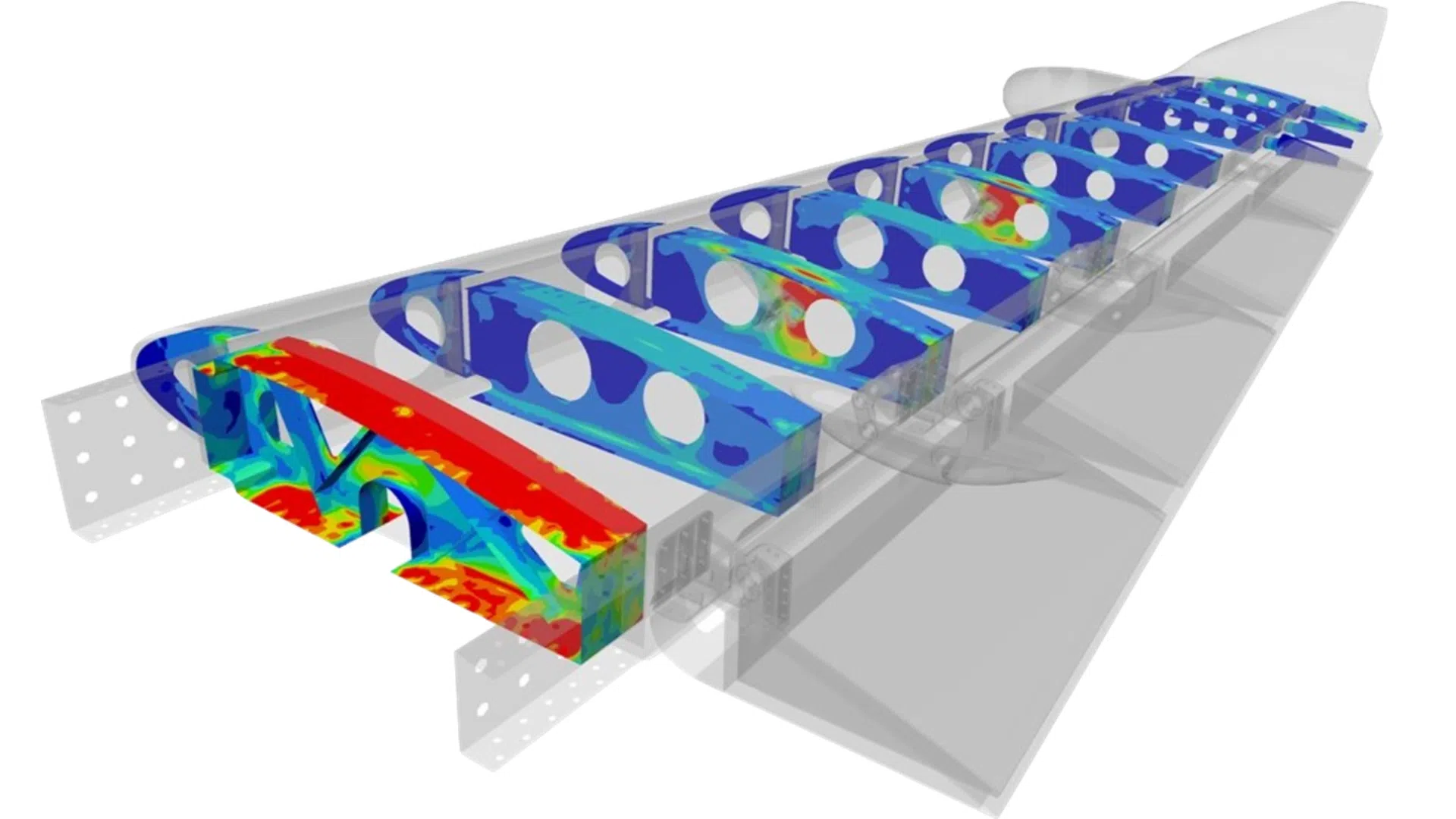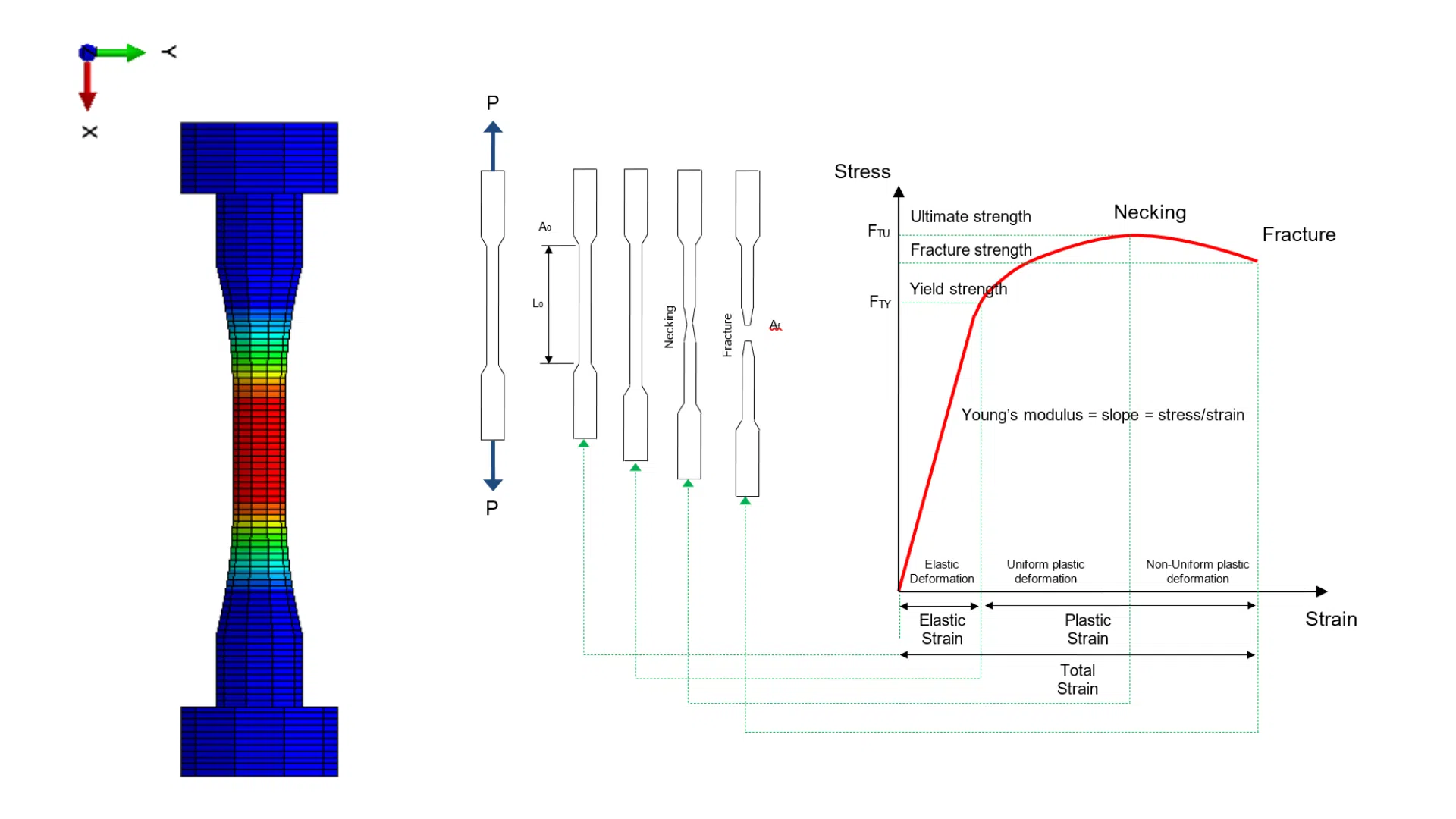Finite element analysis is an approximate numerical solution applicable to a wide range of engineering problems. Applications range from the simulation of structures and mechanical systems in different fields such as aeronautics, naval or civil industry, to the analysis of heat flow fields, fluids or CFD (Computational Fluid Dynamics), magnetics, …
The application of the method starts from the discretisation or subdivision of a complex region into simpler geometric shapes called finite elements. The properties of the material are considered on these elements, which are assembled, and together with loads, constraints and boundary conditions give a set of equations, which resolution gives us an approximation solution of the real solution to the problem under study.
FEM (Finite Element Method) Simulation or FEA (Finite Element Analysis) Simulation
The use of simulation tools, such as the finite element method, is crucial for the analysis and optimisation of complex and highly responsible structures. The complexity of the problem to be studied can come from the topology of the structure itself, the acting loads (linear static, non-linear, dynamic, impacts, …) and the behaviour of the materials (isotropic, anisotropic, plasticity, creep, …), problems that in many cases cannot be solved by analytical methods or tests.
The Finite Element Method applied to the calculation and analysis of structures and mechanical systems offers important advantages compared to traditional approaches. The main advantages are:
- Minimises the need for testing on prototypes.
- It expands the capacity to study the different variables that define the problem: load cases, configuration, …
- Improve structural optimisation
- Reduces project development times
- Allows the detailed study of complex configurations
In summary, the FEM Finite Element Method allows us to study complex structural configurations in depth, increasing their quality and safety, while reducing development cost and lead times, and manufacturing costs by optimising materials.
The use of these technologies is common in many industries such as the aeronautical, civil, automotive, naval, and offshore sectors, and increasingly in industrial sectors of lesser responsibility, but which have found in the cost saving derived from structural optimisation an opportunity for improvement and innovation through the application of FEA (Finite Element Analysis) simulation techniques.
ICEMM, Company Specialising in Finite Element Analysis and Calculation
When it comes to obtaining accurate and reliable results in the field of finite element analysis, it is essential to have the experience and expertise of a specialised company.
ICEMM is a leading engineering company in its field of specialisation, recognised for its commitment, focus on its clients and the quality of its work. At ICEMM we have 18 years of experience in Finite Element Analysis in different industrial sectors, a quality that allows us to transfer technology between industrial sectors, improving the processes and the quality of the services provided to our clients.
The quality of our work is guaranteed by the recurrent contracting of large national and international industrial companies such as Airbus, INDRA, Navantia, ELECNOR, SENER, … and also smaller companies that entrust their developments to our company.
Finite Element Calculus: What does ICEMM offer?
ICEMM is recognised for its expertise and leadership in the field of finite element calculation. Its team of experts combines in-depth theoretical knowledge with practical skills and experience, enabling them to tackle projects of varying complexity with confidence and precision.
ICEMM also has first-class tools that are widely endorsed by industry and the scientific community, such as Abaqus Standard/Explicit, MSC Nastran, Optistruct and Radioos as solvers and Hypermesh/Hyperview, Patran and Abaqus CAE as pre-post processors.
ICEMM’s experience enables us to solve a wide range of simulations and analyses using the finite element method on structures. This includes static analyses, both linear and non-linear, dynamic analyses ranging from vibrations and transient phenomena to high-speed impacts, as well as thermal and thermo-mechanical analyses. We also have experience in the acoustic field, tackling low and medium frequency problems, as well as in the detailed characterisation of complex materials, including aspects such as plasticity, creep and viscoelasticity, among others.
In our company we are strongly committed to research and continuous innovation, carrying out recurring R&D projects, an activity that has enabled us to obtain the Innovative SME qualification. It is also worth highlighting the achievement and development of the Railcrack project, a project co-financed by the CDTI on predictive maintenance techniques in rails for fatigue fracture due to cyclic loads.
Conclusions: Advancing in Finite Element Structural Analysis
In summary, finite element structural analysis is an essential tool for experts at simulation of structures. It allows a deep understanding of the behaviour of materials and structures, resulting in more efficient and safer designs. Companies specialised in this field, such as our company, play a crucial role in the improvement of the industry.
Ultimately, knowledge and effective application of finite element analysis is crucial in modern engineering and design. With the use of tools such as FEA and FEM simulation, and collaboration with leading companies in the field, structural simulation experts are better equipped than ever to tackle complex challenges in structural design and engineering.


